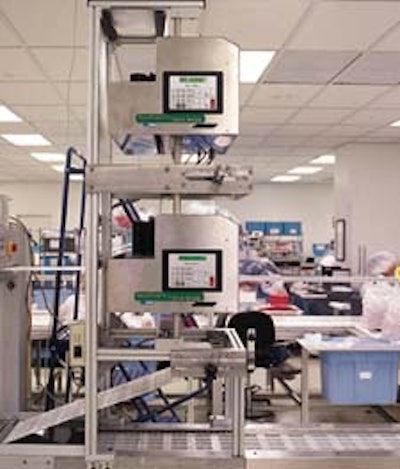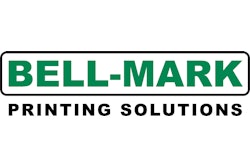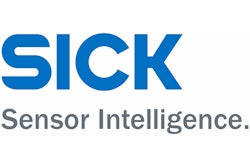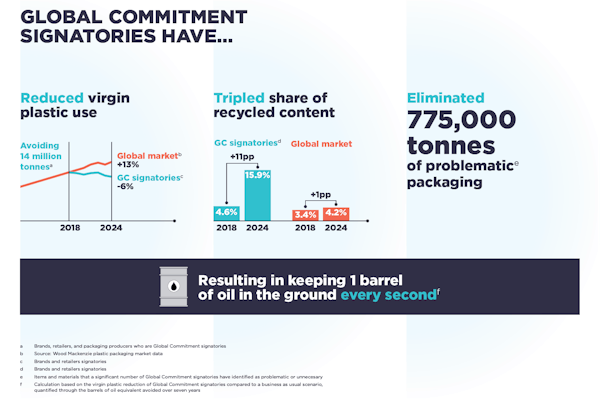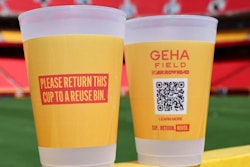Improved legibility and reduced labor costs are just two of the benefits enjoyed by Merit Medical Systems since thermal-transfer printing became part of its medical-device packaging line. The new equipment also means that the South Jordan, Utah, firm is now able to
• print symbols required in the international marketplace, thus eliminating extra labels applied to lidstock
• do custom printing for customers whose products are contract-manufactured and packaged by Merit, and
• rely on automatic dating, which greatly reduces the chance for human error in the date-code information that’s necessary on the lidding material.
Disposable surgical devices for cardiology and radiology procedures are what this South Jordan, UT, firm manufactures. The devices are loaded by hand into cavities formed on a Multivac (Kansas City, MO) M-855 thermoform/seal machine. The Multivac is equipped with five sets of tooling for a variety of package configurations. Maximum depth of draw is 1 ¼”, and the rated speed of the machine is 10 cycles/min. The Multivac also heat-seals flexible lidding to the filled thermoform.
Before the new on-line printing equipment arrived about a year ago, a dot-matrix printer mounted on the Multivac was used to imprint the lidding material with basic product and manufacturer identification. Other important information, like company address and customer service phone number, wouldn’t fit, so it had to be added to the corrugated shipper label.
The above scenario was further complicated when product was destined for overseas markets. As many as six workers had to give each package pressure-sensitive labels printed with symbols and/or copy required overseas. Now all the information required is printed by Merit on the package’s lidding material. Overlabeling is a thing of the past.
Merit prefers not to quantify the reduction in labor costs since the new on-line printing equipment was installed. But according to packaging engineering manager Jeff Novak, the savings was “substantial.” As for the workers, they’re redeployed more productively elsewhere in the plant.
Mounted on the thermoformer
The thermal-transfer printing equipment selected by Merit was supplied by Bell-Mark (Pine Brook, NJ). Two of Bell-Mark’s Easy-Print C programmable traversing machines were mounted to the framework of the Multivac machines.
“We’re light years ahead compared to how we used to do it,” says Novak. Efficiency in overseas shipments, he notes, is dramatically improved.
“The printer we had before only allowed us to print text,” explains Novak. “Our logo was preprinted on the lidstock, and we added part number, lot number and expiration date in text.
“The problem we encountered is that the European Medical Device Directive issued in June of 1998 identified certain symbols, accepted by all EU nations, that must be used on packages destined for EU markets. Until we installed the on-line printers, we added these symbols by overlabeling each package, not only at the manufacturing plant in Utah but sometimes also at our European or Asian distribution center. That was time-consuming and expensive.”
Only some of the symbols are strictly required by the EU. An example is the “CE” mark and certification number indicating that a product has been inspected and is qualified for sale by European standards. Other symbols are merely recommended; but if text is used instead, it must be translated into multiple languages. That’s not easy on a small package.
The Bell-Mark machines are traversing printers, so the printhead moves across the lidding material each time it’s advanced by the Multivac machine. As the printhead moves across the film, it transfers the image by pressing a thermal-transfer ribbon onto the lidstock to imprint one lid image for each package in the row.
Maximum print length for each print head is 5”. Because two printers are stacked, Merit can print a lidstock image that’s longer than 5”, with one printer handling the front portion and the second printer handling the back. Or, if the print length on a package is less than 5”, printing can be done two rows at a time.
Product data is stored in the label-creation software, which an operator can access through a PC. New print designs are created with the same software. Windows™-based, the software is “very user friendly,” which is a big help in minimizing changeover time, says Novak.
“We run about 100 different products through this machine,” says Novak. “For large orders, we may run the same product all day, even longer in some cases. But on other days we’ll change several times in one day.” The line typically runs 10 hours, four days a week, says Novak.
The versatility provided by the software also helps Merit in the contract manufacturing/packaging work that it does for other marketers of medical instruments. Rather than having to inventory lidding material preprinted with the customers’ logos, Merit can use the same unprinted lid stock and print logos on-line.
Novak says a soon-to-be-implemented upgrade to LabelView™ software from Teklynx™ (Milwaukee, WI) will link multiple users over a local area network so that print commands can be sent from a variety of locations.
“Suppose the machine operator on a given shift who is responsible for sending print jobs to the Bell-Marks calls in sick,” says Novak. “Someone in engineering or quality control can send the print job over the LAN.”
Symbols hold info
The stop-cock package shown at the top of this page illustrates how many symbols Merit now prints on its lidding material. The hourglass, for instance, is internationally recognized as a symbol meaning “use by.” The device in this case is not to be used after March of 2003 because its sterility can’t be guaranteed past that date. Even the method of sterilization, ethylene oxide, is indicated in a graphic element recognized around the world: STERILE EO. Had the device been sterilized by radiation, it would read STERILE R.
Also prominent is the CE mark and a circled 2 with a slash through it: the international symbol for “do not reuse.”
The notice that the device is nonpyrogenic (ie., contains no bacterial matter capable of causing fever) is printed in English, French, Spanish, German and Japanese. Before on-line printing, this information would have been supplied on an extra label applied by distribution centers in Europe or Japan.
Above the multilingual “nonpyrogenic” copy is a bar code, useful in domestic as well as global markets.
“In that bar code is a Universal Product Number (UPN) that major customers around the world require,” says Novak. “They want to track inventory and reorder using bar-code scanners the same way you see it being done with UPCs in the aisles of retail stores.”
The UPN bar code, also imprinted in its human-readable format, contains three items of information. First is H656, which Novak calls a “labeler identification code,” or LIC.
“That tells the world that this is a Merit Medical Systems product,” says Novak. “The number is assigned internationally to Merit.”
Next is a catalog number, MS111LG, and finally a “packaging level indicator,” in this case a zero, that carries information on quantities that should be reordered.
Two other pieces of information on the stopcock package are Merit’s headquarters address and phone number and its European contact in Ireland. In the days before on-line printing, this information wasn’t on the primary package. It was provided only on the shipper.
“It’s much better to have it on the package itself,” says Novak. “If the device becomes separated from its shipper, everything that needs to be known is there on the package.”
Novak also appreciates the automatic real-time dating feature that is part of the Bell-Mark equipment.
“The printers automatically pull in things like expiration or manufacturing dates,” says Novak. “Not only does it reduce the number of things an operator must do when beginning a new work order, it also eliminates the possibility of operator error in entering dates.”
As Packaging World goes to press, Merit was completing the installation of a new Multivac system in its Salt Lake City facility, and mounted to it will be a single Easy Print C thermal-transfer printer. Print lengths on the new line won’t be as long as they sometimes are on the other line, so there’s no need to stack two printers this time. Another system has been purchased for use in Merit’s facility in Ireland. The objective is plain.
“We’re looking to expand our markets overseas, and these machines will help us do that,” says Novak.
See sidebar to this article: Material makeover, too
